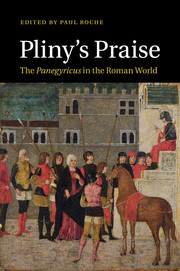Book contents
- Frontmatter
- Contents
- List of contributors
- Preface
- 1 Pliny's thanksgiving: an introduction to the Panegyricus
- 2 Self-fashioning in the Panegyricus
- 3 The Panegyricus and the Monuments of Rome
- 4 The Panegyricus and rhetorical theory
- 5 Ciceronian praise as a step towards Pliny's Panegyricus
- 6 Contemporary contexts
- 7 Politics and the sublime in the Panegyricus
- 8 Down the Pan: historical exemplarity in the Panegyricus
- 9 Afterwords of praise
- Bibliography
- Index locorum
- General index
8 - Down the Pan: historical exemplarity in the Panegyricus
Published online by Cambridge University Press: 05 June 2011
- Frontmatter
- Contents
- List of contributors
- Preface
- 1 Pliny's thanksgiving: an introduction to the Panegyricus
- 2 Self-fashioning in the Panegyricus
- 3 The Panegyricus and the Monuments of Rome
- 4 The Panegyricus and rhetorical theory
- 5 Ciceronian praise as a step towards Pliny's Panegyricus
- 6 Contemporary contexts
- 7 Politics and the sublime in the Panegyricus
- 8 Down the Pan: historical exemplarity in the Panegyricus
- 9 Afterwords of praise
- Bibliography
- Index locorum
- General index
Summary
distincte definiteque designat
(Pan.88.6: ὁρισμός / παραδιαστολή / ὁμοιοπρόϕορον)INTRODUCTION
Pan[egyricus] is addressed through the senators in session (patres conscripti, 1.1). Thanksgiving is directed to the gods for their gift of an Optimus princeps before the speech turns towards parens noster for allowing the event: Caesar Auguste (4.3). A secundary function, thanksgiving by the speaker for appointment to the consulate, is subjoined, in a doubly self-reflexive address on behalf of Pliny and his colleague Cornutus Tertullus (90.3); and here the performance thanks Trajan both as consul on behalf of the Roman state and on Pliny's, too (tu…, suo quoque nomine, 91.1; cf. 90.3). Trajan and his new pair of (suffect) consuls give and get the glory generated over again whenever recitation of the speech evokes another ‘here and now’ for its ‘we and this’. Besides these protagonists, Pliny will find cause to name a clutch of figures from Roman history: on the one hand, heroes of the republic, pegged to the earliest phase through the Hannibalic War and into the second- and first-century finale – Fabricii, Scipiones, Camilli (13.4); Bruti, Camilli again (55.6); Papirii and Quinctii (57.5); Pisones, Laelii and Metelli (88.6); on the other, the proto-emperor Pompey (29.1).
- Type
- Chapter
- Information
- Pliny's PraiseThe Panegyricus in the Roman World, pp. 142 - 174Publisher: Cambridge University PressPrint publication year: 2011

